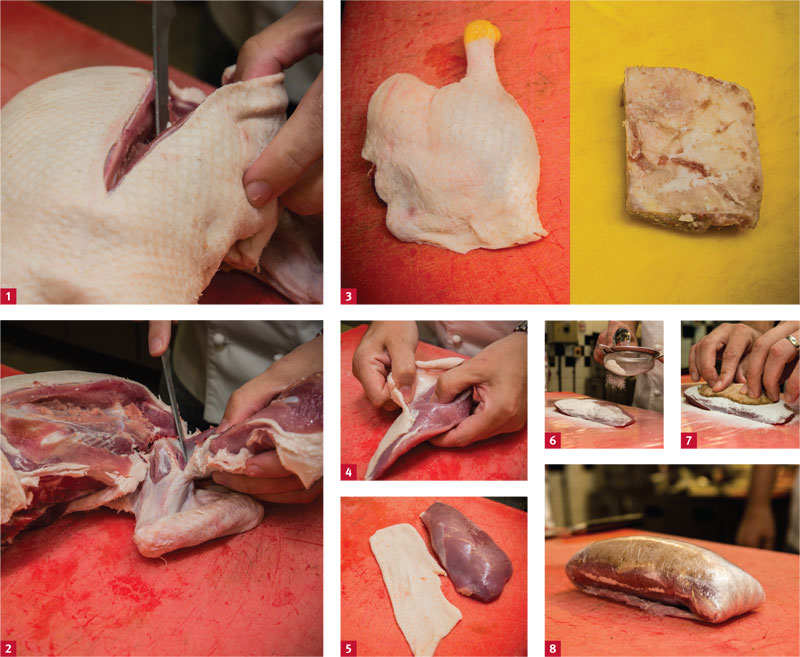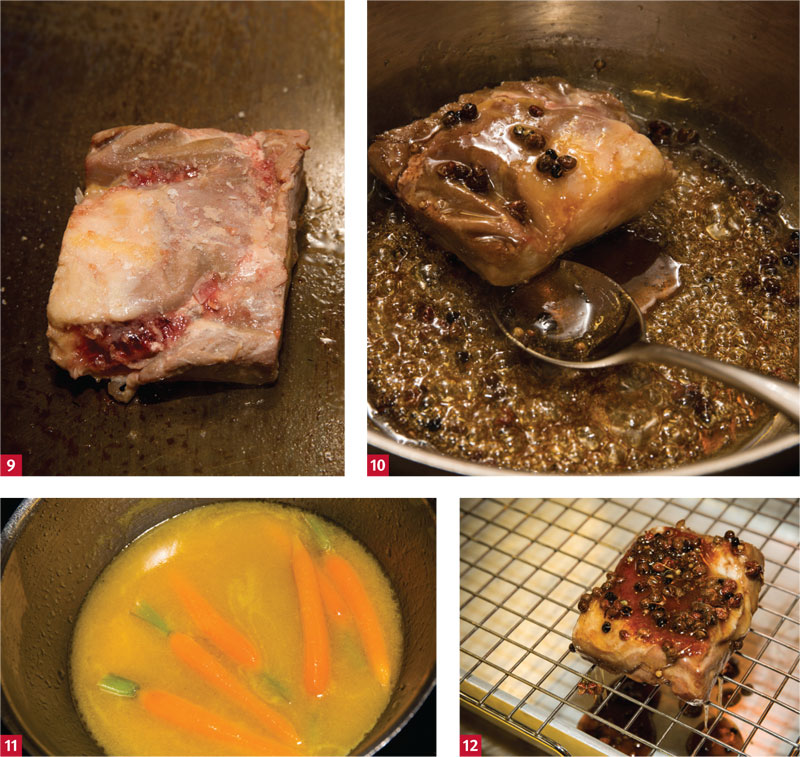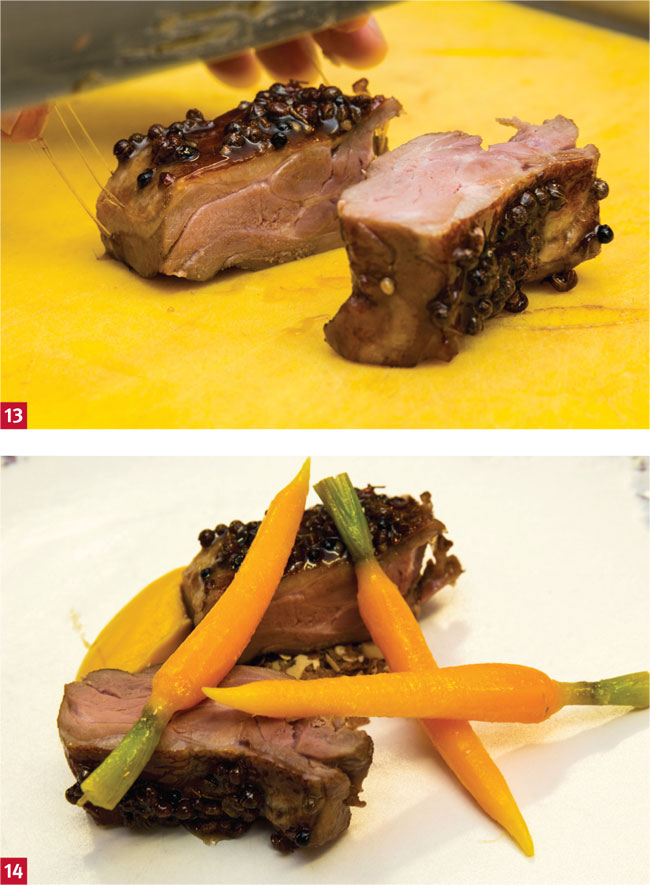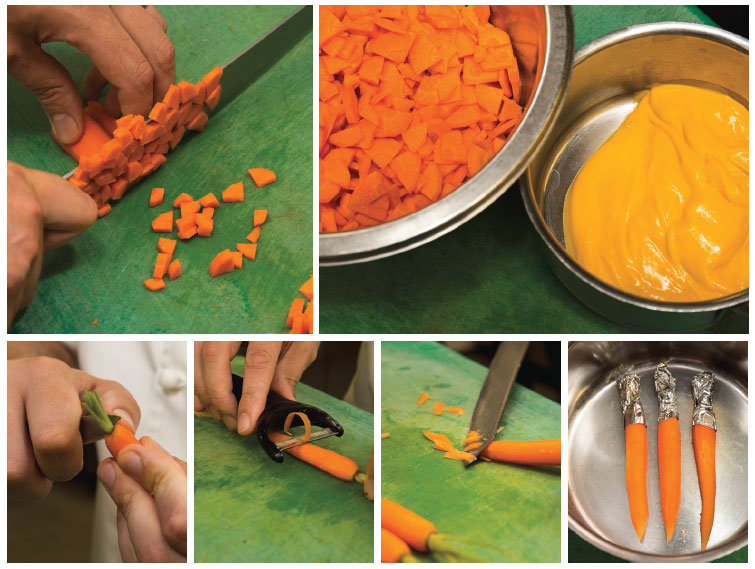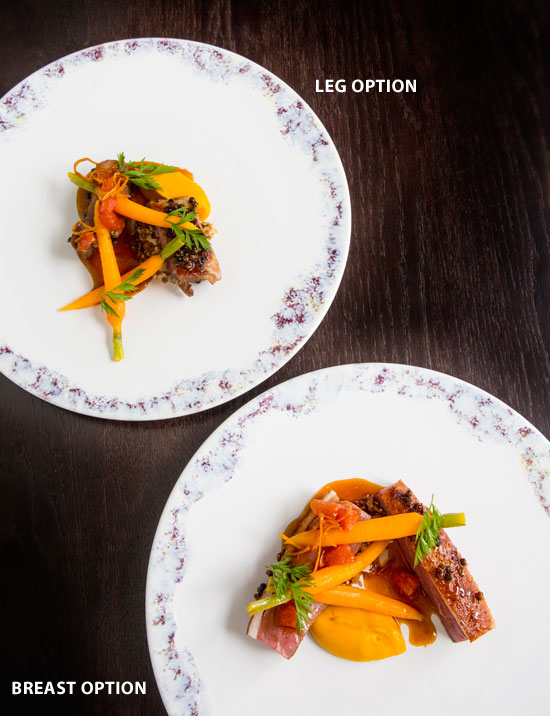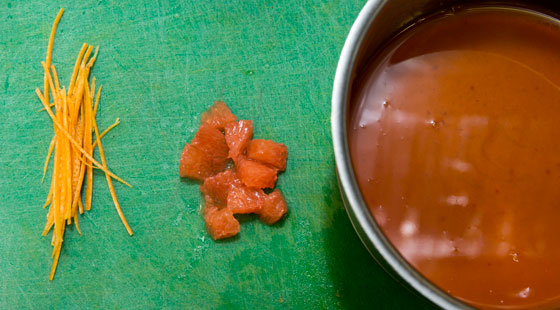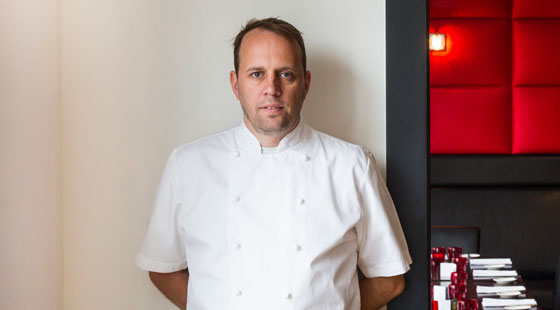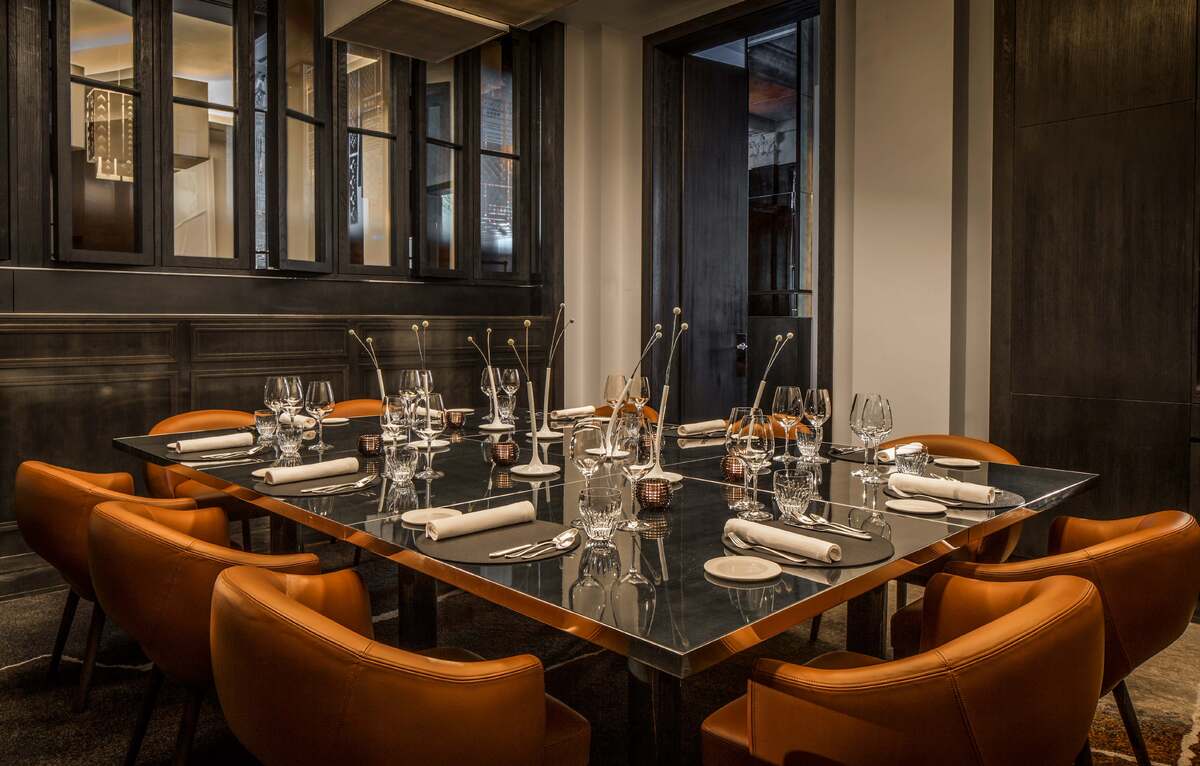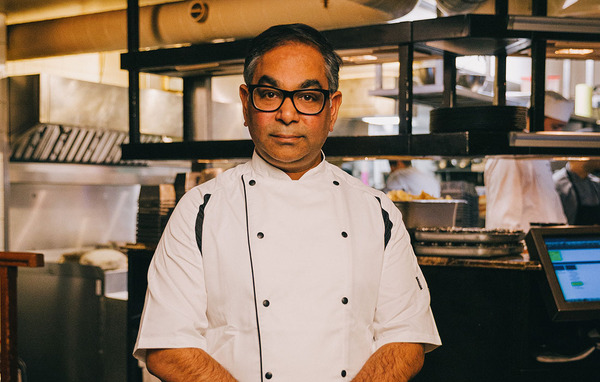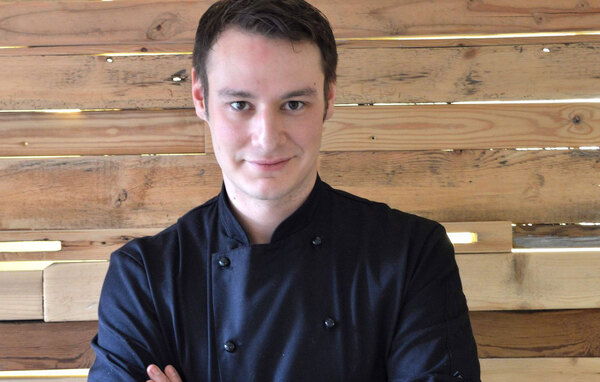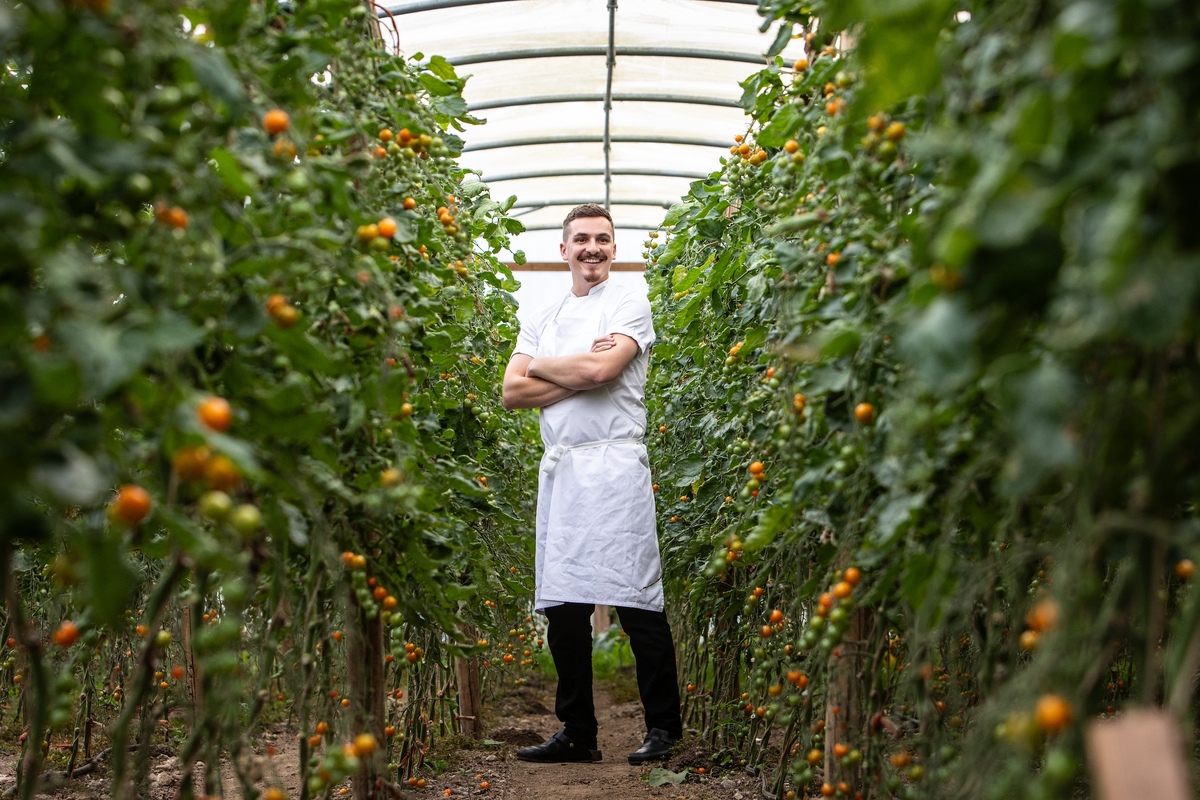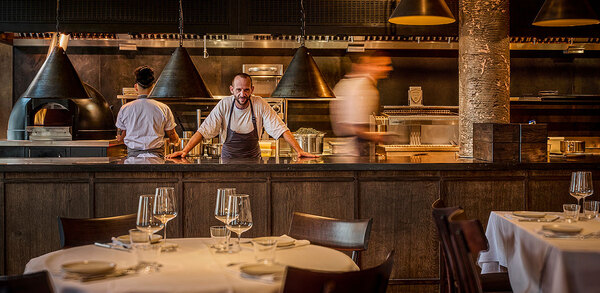Chef masterclass: duck with Mark Poynton
Chefs face a conundrum when serving duck. They want the breast meat to be pink, whereas the leg meat needs to be cooked through. One solution is to cook the breast to order and turn the legs into confit.
Chef Mark Poynton of Alimentum in Cambridge has given the concept a twist. After boning the Creedy Carver ducks, he channels the legs to his lunch menu and the breasts to his dinner one. Except for the way he prepares the two types of meat, the recipe and presentation are the same. Itâs a take inspired by that onetime favourite, duck à lâorange, beefed up with a smidgen of Szechuan fusion.
He slow-cooks the boned legs until they are tender, while the breasts are brined ahead of service and cooked pink to order. Both recipes are served with the same sauce, the same accompaniments and the same presentation.
Batch sizes and planning
Alimentum prepares batches of 12 ducks, which convert into 24 lunch and 24 dinner portions. After the meat has been prepped:
⢠The duck bones and the trimmings go into the stock (and ultimately the sauce) while the extra fat is rendered.
⢠The legs are vac-packed in large pouches and cooked for 10 hours, then cooled, trimmed and portioned.
⢠The breasts are skinned and the skins are vac-packed and cooked for 10 hours, then reassembled with the breasts before portioning.
⢠Carrots are prepped ahead of service.
⢠The grapefruit is prepped ahead of service.
⢠For each order, the meat is cooked and then plated up with the other elements.
Costing
Alimentumâs costing devolves from the £70 three-course à la carte dinner, where the main course has a nominal value of £35. Poynton aims for 70% gross profit on this menu, which is based on the price of the whole duck being sold as two portions.
His £35 lunch menu also operates on a 70% margin. For this, the duck legs have already been priced into the duck dish on the dinner menu, so they cost him nothing.
Duck preparation
The basic preparation is the classic boned poultry method. Remove the two legs thighs and drumsticks) in a single piece (1); remove the two breasts as magrets without the wings) (2)(3). Pull off the âfilletsâ and use for canapés or, as Alimentum does, for staff meal stir-fries.
Legs
Pack the legs flat in vacuum pouches. Put them in a water bath at 65ºC. Poach for 10 hours, then cool and press. Trim the legs into neat squares and then repack individually ahead of service.
Breasts
Peel the skin off the breasts. Push back the skin to the sinew that joins the skin to the meat. Use the point of a knife to separate the skin from the meat here and pull the skin away from the breast (4-5).
Vac-pack the skins, cook in a water bath for 10 hours at 65ºC and then cool. By now, the skins will be a little smaller than the breasts.
For each portion of breast, lay a sheet of film over the work surface. Sprinkle a thin coat of transglutaminase (meat glue) over the shiny side of the breast (6). Put the skin on top and press it down neatly to make it stick (7). Roll up the film tightly around the duck and reserve ahead of service (8).
Duck, pink grapefruit, carrot, maple syrup and Szechuan pepper
The only difference between the lunch and dinner dishes is the final preparation of the duck: the leg portion weighs less and goes directly on the plancha, while the breast is poached in a water bath first.
Serves 1
1 prepared duck leg for lunch or 1 prepared duck breast for dinner
Maldon salt
1dsp Szechuan peppercorns
50ml approx maple syrup
100ml orange-butter emulsion
3 prepared carrots
1tbs carrot purée
1tbs house granola
50ml sauce base
Squeeze of reduced grapefruit juice
1 segment pink grapefruit
1tsp candied grapefruit zest
Carrot leaves to garnish
To finish the leg: put it skin-side down on the plancha and season lightly. Let it sizzle long enough to crisp the skin. Turn it over and sear the meat long enough to heat it through.
To finish the breast, poach the wrapped breast for 25 minutes at 62ºC. Unwrap and lay it skin-side down on the plancha (9). Season lightly. Crisp the skin. Turn over onto the meat side and sear for about two minutes more.
Heat the Szechuan pepper in a sauté pan that is just large enough to hold the meat. When the pepper becomes fragrant and starts to smoke, add the maple   syrup. Let it boil and then add the duck to the pan, skin-side up (10).
Baste thoroughly and set aside. Boil and reduce the orange-butter emulsion to a light glaze. Add the carrots and let them heat through (11). Heat the carrot purée.
Heat the sauce and add a squeeze of grapefruit juice. Add the candied zest to the sauce. To plate up, place either the leg or the breast on a rack over a drip-tray (12). Spoon the maple syrup and Szechuan pepper over the meat to coat it. Cut the meat in half and arrange in the centre of a plate, skin-side up (13).
Put a spoonful of granola between the pieces of duck. Arrange a quenelle of carrot purée to one side and place the glazed carrots on top (14). Cut the grapefruit segment into four or five pieces and lay them on the duck skin. Add the candied zest to the finished sauce and spoon a little sauce around the meat. Finish with sprigs of carrot leaf.
Sauce base
Chop the duck carcasses and wings into small pieces. Trim away any fat or fatty skin to render down. Roast the bones until they are brown and then strain off any fat. Deglaze the an with chicken stock.
Transfer the bones to a large pan and add enough stock to fill. Boil, skim and simmer to extract the flavour â" the simmering time will be about three hours.
Strain the liquid through a fine-meshed chinois into a clean pan. Reduce to a   demi-glaze, skimming and degreasing throughout. Season lightly.
Alimentumâs granola
Combine roughly equal amounts of caramelised puff pastry trimmings, oats and flaked almonds with maple syrup and icing sugar to taste. Bake for five minutes in a medium-hot oven.
Carrot accompaniments
Carrot purée
Peel maincrop carrots and slice them thinly (the smaller the pieces, the faster they cook and the more flavour they retain). Weigh them and put them in a pan with 10% of their weight in butter and 10% in water. Cook for 20 minutes. Season and then blend in a Thermomix or similar food processor. Vac-pack and store till service.
Baby carrots
The batch size is based on three carrots per portion. Cut off the leafy tops of the carrots, wash and reserve the sprigs for garnishing. Cut the stalks off the scrubbed carrots but leave about 3cm attached. Trim the points so they are all the same length. Clean round the tops where they join the stalks and wrap foil ightly around each stalk to protect it.
Poach for five minutes in an emulsion of two parts butter, one part orange juice and one part water. Remove the foil, cool the carrots and vac-pack ahead of service.
Pink grapefruit
Scale up as necessary. For the candied zests Peel the zest from the grapefruit and scrape off any pith. Fine-julienne the zest. Blanch three times and then cool and eave to dry out. Place in a pan over a moderate heat to remove any remaining moisture. Sprinkle over some caster sugar and boil the sugar to a light caramel.
Put the zest on a rack or similar over a pan to dry. For the grapefruit segments Pare away the pith from the peeled grapefruit. Cut between the segments to separate them (the classic, basic technique). Reserve the segments for garnish.
For the reduced grapefruit juice Squeeze any juice from the pared fruit into a pan. Boil the juice until it is reduced by half.
Cool and reserve in a squeezy bottle to finish the sauce.
Mark Poynton
âEven when I did Great British Menu they said I was Daniel Cliffordâs protégé. I donât think they ever used my name once.â
Chef Mark Poynton doesnât say this with any hint of resentment. Heâs grateful for  the reviews describing Alimentum as a mini-Midsummer House when he opened in 2009, when, he agrees, he was very much a Clifford clone. âItâs difficult to break away from someone so strong-minded and strongwilled. It takes time,â he says.
But seven years down the line, his individual style is taking shape. The disciplines and techniques synonymous with his mentor are firmly there, but Poyntonâs food is lighter. He enjoys adapting the flavours of Singapore (where heâs cooked), India (which heâs visited four times) and China (as with the Szechuan pepper in his duck recipe) to the British style of dining. The trick, he said, is to balance fusion flavours with the British appetite for large chunks of protein.
Heâs also very much a hands-on chef, who puts in eight shifts a week. âI must be the worst-paid Michelin-starred chef in the country,â he says. And he has just opened his first pub restaurant, the White Horse in St Neots, near Cambridge.
He says that when he imagined his career path as a young chef he aimed to be a head chef by the age of 30 and own his own restaurant by 40. As it turned out, he was Cliffordâs head chef at 25, and owned his first restaurant at 31. Still in his thirties, he now has a second business.



